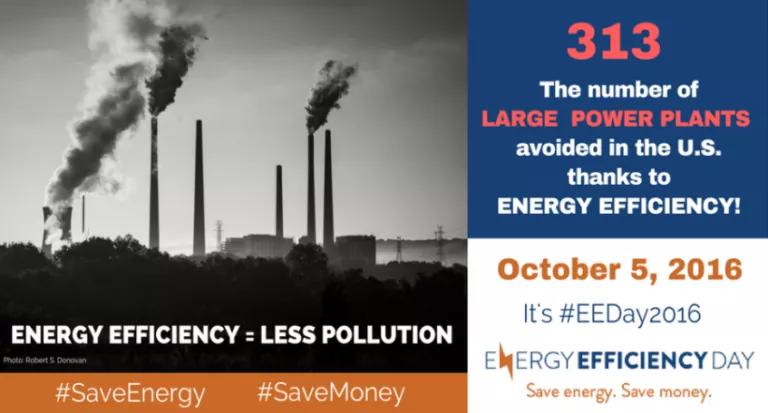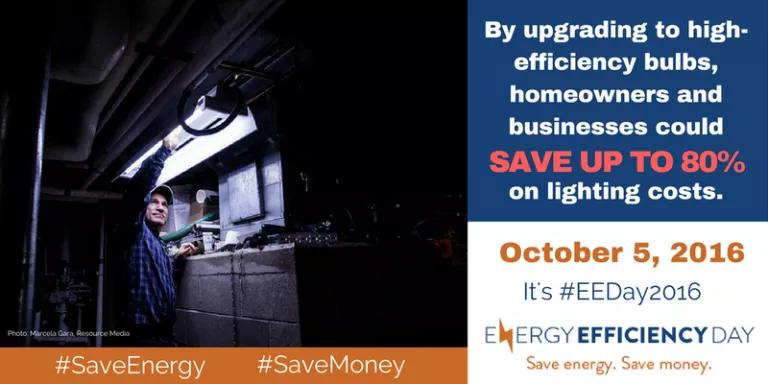
Energy efficiency is often called the “invisible” or “hidden” fuel as it allows us to avoid ever having to physically generate those saved units of energy—but for the first time, this important “resource” will be recognized with its own day. Today is “EE Day.” a collaborative effort of many organizations working to promote the importance of energy efficiency, including the Natural Resources Defense Council and many others, along with additional support from a number of utilities, private companies, and federal agencies.
What is energy efficiency?
Energy efficiency means smarter energy use. Energy efficiency is about using better technology and practices to use less energy to accomplish the same tasks, while continuing to keep homes and businesses comfortable.
More than half of all the energy produced in the U.S. is currently wasted; in fact, estimates range from 61 to 86 percent. This energy is lost across the energy system: when generating energy, when transmitting and distributing energy to consumers, and finally when the delivered energy is actually used to power our appliances, vehicles, and equipment. However, the public still bears the costs and pollution from all of this “lost” energy.
By improving the efficiency of appliances, buildings, vehicles, and transmissions systems, we can reduce the amount of energy lost every year without compromising comfort or economic growth. In fact, reducing energy waste through efficiency helps keep U.S. businesses competitive, promotes jobs and economic growth, and improves both indoor and outdoor air quality.
Efficiency standards and programs save consumers money and reduce pollution
Despite a few attempts to portray it as ineffective or costly, energy efficiency has been shown again and again to be a vast, low-cost option for consumers and an effective way to protect public health and reduce carbon pollution because reducing the energy demanded by consumers and businesses means less fossil fuels burned to keep the lights and the nation running. Every state has at least some experience delivering energy efficiency programs and implementing standards. These programs and standards are proven successes.
The federal government has been implementing and updating national energy-efficiency standards for appliances since 1987. These standards cover most consumer appliances, and represent around 90 percent of the average household’s energy use. As a result, American consumers saved $63 billion on their utility bills in 2015 alone, or an average of $500 per household. By 2030, consumer savings from existing standards will total nearly $2 trillion and will have also prevented 7.3 billion tons of carbon dioxide emissions since 1987, equivalent to the annual greenhouse gas emissions of 1.5 billion automobiles.
Efficiency standards also apply to new homes, offices, factories, and vehicles. Building programs and standards not only reduce a building’s energy use, but can also cut a building’s maintenance, waste, and water needs. In fact, between 2015 and 2018, LEED-certified buildings (the most widely used green building rating system) in the United States will save more than $2 billion on energy, water, maintenance and waste combined. On the roads, improved air quality thanks to new car fuel economy standards is expected to save 100 to 300 lives each year, avoid 14,000 lost workdays, and have other health benefits, worth $1 billion to $2.5 billion annually.

Appliance and building standards—in addition to state policies, such as building codes, and utility- or third-party run efficiency programs—have played a huge role in meeting energy demand reliably and affordably, while reducing harmful pollution. In 2015 alone, energy efficiency directly reduced carbon pollution by 490 million tons, about the combined electricity-related carbon emissions from the Texas, California, New York, Ohio, and West Virginia. Since 1990, America has successfully avoided the need to build 313 new large power plants due to energy efficiency—an amount equal to nearly half of all the existing coal plant capacity in the United States in 2012.
Increasing investments in energy efficiency through improved standards, codes, and programs could meet one-third of expected electricity needs over the next 14 years and avoid the need for another 487 large power plants.
What can you do?
There are a number of easy, no and low-cost measures you can take to reduce your energy use and the associated global-warming carbon emissions from your lifestyle.
- Turn off lights and appliances when leaving a room or house. Before leaving for a longer trip, unplug all unnecessary devices.
- Turn down the heat in the winter and use the A/C sparingly in the summer: The U.S. Environmental Protection Agency recommends keeping your home heated to 68°F during the day and 60°F at night in the winter. In the summer, the Department of Energy recommends setting the thermostat to 78°F when home, and at a higher temperature when away.
- Stop always-on devices from guzzling so much energy: Many devices consume electricity even when you’re not using them. A recent NRDC study found that as much as $19 billion worth of electricity may be wasted in U.S. homes by devices when they're not being actively being used. Use our self-diagnosis and action guide to make changes in your home. Unplugging devices that are rarely used, making better use of power strips and timer,, and adjusting electronic devices to automatically power down when not in use should substantially reduce your idle load.
- Adjust the power settings on your electronics: In the picture set-up menu on your TV, choose the “home” or “standard” screen setting—the “vivid” or “retail” settings are unnecessarily bright for most home use and, more important, they burn 15 percent to 20 percent more energy. More tips can be found here.
- Replace your showerhead: A low-flow showerhead reduces water consumption and energy usage to heat the water—and will pay for itself through utility bill savings in only four months.

- Install one or multiple LED lights: An LED light bulb uses at least 75 percent less energy, and can last up to 25 times longer, than old-fashioned incandescent lighting.
- When purchasing a new appliance chose an energy-efficient model. Look for ENERGY STAR® appliances, which use between 30 and 40 percent less energy than standard models.
- Drive Smart: To improve fuel economy and reduce greenhouse gas emissions unload unnecessary items in your trunk to reduce weight, take your car in for regular tune-ups and maintenance, and check your tire pressure regularly to ensure they are not under-inflated.
- When possible, take public transportation, bike, walk, or carpool: Leaving your car at home just two days a week can reduce your greenhouse gas emissions by an average of 2 tons per year.
These are just a few ways you can make every day Energy Efficiency Day!




